Disgrifiad
Nodiadau manwl yn y Gymraeg a'r Saesneg, 1943, a oedd yn ymateb i holidaur Amgueddfa Cymru ar ddiwylliant gwerin Cymru, 1937, gan Charles H. Humphreys. Hefyd llythyr a anfonwyd ganddo at Dr. Iorwerth Peate (5ed o Fawrth 1943) fel atodiad i'r nodiadau.
Trawsgrifiad
[LLYTHYR]
[MS 83_0001]
Mounteinion,
Llanfair,
Montgomeryshire.
Mawrth 5ed 1943
Anwyl Dr Peate,
Yr wyf yn ddiweddaf wedi darllen eich llyfr ar "Diwylliant Gwerin Cymru"gyda blӓs.Yr wyf yn cymryd diddordeb mawr mewn hen bethau fy hunan.Ar eich cymhelliad yr wyf yn anfon nodiadau mewn atebiad ir Holwyddoreg yn Atodiad B.Efallai nad yw fy sylwadau o werth nac o ddiddordeb i neb arall ond rhag ofn ei bod yr wyf yn ei hanfon. Gobeithio na xxx eich amynedd. Rhaid i mi ymddiheuro am eu
[MS 83_0002]
hysgrifenu mewn Saesneg am fod fy Ngymraeg ysgrifenedig ym mhell iawn o safon y ddisgwilir heddiw.
Yr Eiddoch,
Charles H. Humphreys
[MS 83_0003]
Nodiadau mewn atebiiad i
Holwyddoreg ar Ddiwylliant Gwerin Cymru Mawrth 1943
Gan Charles Heber Humphreys,Llanfair Caereinion
A1 a
See Everyday Things in Montgomeryshire Mont.Col.Vol XLVII Part II Page 2
b
Ditto Page 1&2
c There were two skilled craftsmen who lived in Llanfaircaereinion during the first half of the 19th Century, Thomas Williams Pentre and John Jones Joiner. They made some excellent pieces of furniture from local oak timber.
While at work they wore paper hats as old English craftsmen were in the habit of doing.
Clocks
A well known Grandfather Clock maker named Samuel Roberts lived in Llanfair parish during the 18th century. He made some hundreds of clocks also. The Sun Dials in Llanfair and Manafon Churchyard. What is interesting he kept a record of all the clocks he made together with name of purchasers, number of clock, date of completion and price charged. The book in which he kept the record is in the possession of
[MS 83_0004]
2
his great great grandson Mr. William Roberts Llanfair. The following are typical entries in the book.
Benjamin Evans his clock finished Aug 8th 1755 prize (price) two pounds four shillings. Numbered 102
Mr.Tudor Peniarth Meifod his clock was made and finished Aug 28th 1755 prize two pounds four shillings Numbered 103
Mr Humphrey Charles his clock was made and finished Feb 21,1759 Numbered126 Prize £3-15-0 Nine day clock.
Ezeciel Thomas LLanbrynmair his clock was finished Aug 30th 1767 Numbered 265 Prize £2-14-0
Last entry – Widow Baiynon her clock was finished April 15th 1774 Numbered 369 prize £2-7-8
I have in my possession a very old Weather Glass made in Bishops Castle probably over 150 years old.
[MS 83_0005]
3
ch
Picynau fren were used in farm houses in the locality during the latter half of the 19th century from which the farm servants eat their bread and milk and broth &c
dd
The making of tallow candles was carried out on a considerable scale at Dolgoch Llanfair by a family of the name of Dolby.The premises are still called the Chandlas
e
Up to the end of the 19th century square churns with wings inside were used in the large farms of the district. Buddeiau Cnoc were in general use in the small farms and even into the 20th century. They were made in Llanfair.The last cooper Richard Rowlands died about 4 years ago, a skilled tradesman. I will remember him making Buddeiau Cnoc.
A.2 Gwisgoedd.
Smock frocks were generally worn by agricultural workers and small farmers up to the middle of the 19th century and some which I remember much later. These were made in Llanfair by a man
[MS 83_0006]
4
named William Watkin (the pioneer of the Cambellite Sect) who employed several hands. They were made from a material called Drabit, a kind of strong twill, with a pattern [ ] on the front. The smock frocks were taken to be sold in the fairs and markets of North Wales. They would stand any weather and last a life time. When a young man had his smock frock he would not need another in his life time.
Pattens were used up to the end of the 19th century by old ladies I remember.
B2
There are several farms named Llanoddian near Llanfair town and another farm Tanllan. There probably existed an ancient church or local sanctuary older than the present Parish Church of St Mary.
B2 Offrwm
I was present at a funeral at Rhiwlas Llansilin in 1936 when two Offrwms were taken one in the church which went to the parson, and the other was taken on a spade by the sexton at the Churchyard gate.
[MS 83_0007]
5
B2 Collection of Tithes.
When tithes were takenin kind the clergy employed quite a number of men to discharge the duty. They would come to the harvest field and mark off the parsons portion by placing sprigs in the sheaves,to be collected later by the parsons team and wagons.
A tenth portion of the lambs were collected usually the best of the flock. One pig was taken for each litter even if the litter was as small as 2 or 3 and only the one pig if the litter was that of 12 or 15.
Twice a year the parsons official called for the Tithe of eggs. One egg was taken for each hen kept and 2 for the cockerel.
The sum of one penny was charged for the milk of each foal born.
Anti Tithe Demonstration. The tithe sales of the late eighties in the Meifod valley were frequented by great crowds and serious disturbances occurred.
[MS 83_0008]
6
B4 Cludo
Before the opening of the Cambrian Railway the Stage Coach passed through Llanfair on its journey from Shrewsbury to Aberystwyth and Barmouth.The time table is seen in "Pigot & Co Commercial Directory 1828 & 1829"
Stage wagons passed through from Shrewsbury to Machynlleth. The Llanfair carriers were Thomas Humphreys who carried from Shrewsbury to Llanfair and Thomas Davies who carried from the Welshpool Canal. Both parties used 4 wheeled wagons.
The first regular passenger conveyance to run between Llanfair and Welshpool was run by the above mentioned Thomas Humphreys in year 1851. His conveyance was a three wheeled vehicle ingeniously constructed with 3 wheels in order to evade the extra charge at toll gates for a 4 wheeled conveyance. It was called The Exhibition.
Donkeys were largely used in the district, one of the events of the year in Llanfair were the Annual Donkey Races. A man named Jenkins used a team of six donkeys to draw a small wagon carrying coal from Welshpool.
[MS 83_0009]
7
B4
Hatters attending the Llanfair fairs from Tre'rddol conveyed their hats in large band boxes slung across donkeys backs.
Dogs drawing vehicles. My father remembered stall holders who attended the Llanfair fairs conveyed their stalls &c on carriages drawn by large dogs.
C1 Samplers.
I have a finely worked sampler made by one of the Davies family of Tymawr Carno. No date probably early 19th century.
Old Schools.
In Cromwells time 1650-1652 an Act of Parliament was passed to establish cheap day schools in Wales. 14 were established one of them in Llanfair. Among other places to secure these schools were Welshpool Montgomery Llansantffraid and Llansilen. This information is to be found in the works of Morgan Llwyd Cyf ii dan olygiaeth J.H.Davies[ Bangor Jarvis and Foster ]
"The Edward & Davies Charity under a will dated Sept 14th 1685 leaving 40 shillings a year from a farm called Deri Teg, towards teaching ten poor children of the township
[MS 83_0010]
8
to read. Among those who benefited by this charity were the late Mr J Lloyd Peate CC.of Llanfair and the Rev John Pugh founder of the C.M. Forward Movement Mission. Small schools were held in Cottages and Chapels. Areally good school was conducted in the Old Town Hall by a Mr John Dolby date about 1840. The establishing of the British School in 1849 called for a great sacrifice on the part of the Nonconformists of the Parish. A bitter election was fought in 1872 to establish a School Board in which men lost their employment and traders their customers. The establishing of a school board had a far reaching effect on the local life of the parish.
C2 Cock Fighting.
Up to the beginning of the 19th century the sport was common in the parish of Llanfair. Mr E Lloyd Edwards Llanfair has in his possession 3 small silver cups won in cock fighting contests date about 1800. They belonged to his grandfather Maurice Evans of Gwaenynog.
[MS 83_0011]
9
C3 Funeral Customs
The custom of partaking of wine and cake was general up to the middle of the 19th century. It seemed to have been a kind of Sacrament or the idea of Sin Eating ( see Mary Webb Precious Bane). I have in my possession an old Lustre plate that had been used in my mothers family on occasion of funerals for many generations.
Dynion Hysbys.
There were two local Conjurors Old Beddoes and Moses Morgan. The latter died about 1930. These local wizards were frequently vivited by persons from a wide area. One person in trouble sent for the conjuror he wa sunable to go being ill. He however sent his hat instead which was to act as the charm.
Belief in witchcraft exists chiefly along the English borders of Montgomeryshire for instance on the Manafon side of the Llanfair Parish. This is possibly due to the influence of Gwallter Mechain of Manafon who it is said dealt in the black arts.
[MS 83_0012]
10
C3 There are several stories of his wizardry one a very interesting one of the Bottling of the Devil.It would be interesting to know if this is a form of superstition to to be found in other localities or nations. A well known farmer in Llanfair Parish until recently was in the habit of paying a contribution yearly to a Dyn Hysbys to keep evil influences away.
Sacred Wells.
There are several in the district of Llanfair including St Mary's Well in the parish Churchyard where 80 years ago numbers frequented it to be healed from various diseases.
C4b Old Friendly Societies.
A successful Friendly Society was established in Llanfair early in the 19th century called the Meibion Gomer Friendly Society at one time it numbered 500 members. The benefits were 6/- a week sick pay allowance and 3/- a week old age pension at the age of 70. The Annual Club Day was held on March 1st and was one of the chief
[MS 83_0013]
11
events of the year. There was also a local Club at [ Carm ] Office.
C ch Cymdeithasau Llenyddol
At Llanfair between the years 1820 & 1830 there were frequent meetings of literary men poets and others. Gwallter Mechain was prominent among them other members were Idrisen[ ( Ap esboniwr) ] Bardd Einion a Bardd Mawddach the printer. The Society was called "Cymdeithas Cymreigyddawl Llanfair". An Eisteddfod was held on March 1st 1826. See account in Eurgrawn Weslyaidd 1826. ( In the Eurgrawn of this period there are interesting notes relating to the social conditions of the time.
4d The Temperance Revival.
The enthusiasm and excitement in connection with the Temperance Revival about 1840 were remarkable. There were many incidents of interest in connection with that wonderful movement in Llanfair. There was considerable persecution on the part of local gentry, and legal action
[MS 83_0014]
12
4d
followed. The crowds that gathered to the Temperance Cymanfas were phenomenal.
C5 Cerddoriaeth
There is a reference to a visit of a Lord Torrington to Llanfair in 1784 who expressed surprise that there was no harpist in the town "but only a very fine player of the Violin".
There was however Harp playing at the Eisteddfod of 1826 by a Mr Humphrey of Welshpool "gyda medrusrwydd angyffredin". About the year 1840-1850 there was a small orchestra band who played on Sundays in Church and also at the Wesleyan Chapel. Some of the instruments were a Bass Viol, Violin, and a Bassoon. One of the company was J.D. Jones afterwards of Ruthin a native of the Parish. His tune Capel y Ddol was named after the old Chapel he and his father Joseph Jones an old weaver attended at Melinddol near Llanfair.
Brass Band
In later times there was a Brass Band in Llanfair.
[MS 83_0015]
13
CH v Offer
Tools such as Bill Hooks were in the old days of local manufacture. Later they were made in Staffordshire but to local patterns. The pattern generally used in Montgomeryshire is called the Newtown pattern, but there are variations of that pattern and the type used in the Llanfair district is a modification of the Newtown pattern with less hook.
ch Erydr
Several old smiths improved on the Ploughs in use about the middle of the 19th century. William Davies of Craen Llanerfyl had a Shell Board cast to his pattern with his initials on W.D.
The originator of the most decided improvement and whose pattern came into general use throughout the county was Evan Thomas of Meifod who was a brother of Ab Vychan and a very able man in many ways, an excellent poet, better in the opinion of some who ought to know than his brother.
He invented a new pattern Shell Board
[MS 83_0016]
14
or body and had it patented with the mark E.T.no 65. This plough had a great voyage throughout Wales and there are still some in use. Including his own sons there were at one time 8 smiths at work making these ploughs at Meifod during the period about 1865- 1885, and at that time there was an output of 6 ploughs a week from that smithy.The Board was Cast Iron but the share was of wrought iron. The hammered plates for making these shares were obtained from Caergwrle and were of excellent quality shoulder of mutton shares, from which the local smiths forged the Plough Shares.
Ploughing with Oxen. Mr Joseph Jones of Pantredynog Llangadfan who died about 20 years ago well remembered seeing oxen ploughing at Ffridd[gouney] Llangadfan.
His observations were, that they were very slow but liable to bolt if in warm weather they were bitten by flies; for this reason during warm weather ploughing was often done at night.
[MS 83_0017]
15
CH d
The Sowing of corn was usually done by the farmer himself or the most experienced hand on the farm as it required skill and experience. The sowing up to recent years was done by a Seed Hopper Had Lestr. These in recent years were made of Galvanised Iron but old types were made of bent wood kidney shape, with a strap over the farmers shoulders.
dd
Scythes Makers of scythes sold in the county during the 19th century were chiefly Martin and some Waldron they usually measured 48in. A very popular scythe in this county was the Owen Davies scythe. Owen Davies was a Llanidloes man who lived over a hundred years ago.Possibly these were originally made in Llanidloes, but later probably G Nash of Stourbridge. These Llanidloes scythes were in great favour in the upland parts of the county. The blades were narrow with a very strong back rod and
[MS 83_0018]
16
CH dd
considerably longer measuring up to 54 inches long. So very much used for tori gwair rhos.
dd1 Costreli Pren
These were generally used even in recent years for carrying drink,Buttermilk or Cider to the harvest field. They contained 2 to 4 quarts.
CH 3 Gofaniaeth.
Some local smiths had a high reputation as makers of excellent quality tools. One that had such a reputation was William Davies of Craene Llanerfyl. He made Axes, Billhooks and peat irons.
4 Local Industries see copy of article in Mon.Col.Vol XLVI Part II
Printing and Bookbinding Page 108
Malstering and Brewing Page 110 & 111
Shoemaking Page 106
Woollen Manufacturing Page 109
Tailoring Page 106
The Felt Hat Industry Page 108
Clogs Page 107
Mining Page 111
Leather Industries Page 109 &110
[MS 83_0019]
17
CH 4 Making Nets
There were experts in the making of nets in Llanfair. Nets for netting the River for fish and for Poaching of Game. For the latter purpose a rhwyd fawr was used many yards long which was dragged across a field where coveys of partridge were likely to be lying. One of these net makers was Thomas [Ashley].
Fishing An old guide book to North Wales pub. In 1835 mentions about Llanfair "The River abounds with Fish, such quantities of fish as justly to entitle it to the name of Annis Piscorus. The inhabitants of this place are said to excel in the practice of spearing fish".
A d Darluniau
A native of Llanfair John Griffiths born 1837 ( his mother was a native of Machynlleth) was one of the few Welshmen to distinguish themselves in the world of Art. Many of his pictures were hung in the Royal Academy, South Kensington Museum, Buckingham Palace
[MS 83_0020]
18
and other Art Galleries. His great work was however done in India where he was for many years Master of the School of Art in Bombay being associated with Mr Lockwood Kipling father of the Poet. Not many, if any Welshman attained the distinction he secured. There was a lengthy obituary notice of his in the "Times"when he died Dec 3rd 1918.
Cyffion Diwylliant Gwerin Cymru Tud. 52
Mr E. Lloyd Edwards now living in Llanfair age 81, well remembers seeing a man placed in the stocks at Llanfyllin for drunkenness and the children and others jeering at him.
Old Furniture
I have in my possession a good collection of old oak furniture, most of which has been handed down in my wife's and my own families for generations. Among them is a panelled oak cradle that belonged to my wife's family from [ Canmoy ]
[MS 83_0021]
19
Nantyreira and originally from Pwllmelyn Llanbrynmair. See [ ] Chronicle March 1857 Page 72.
Charles Humphreys
March 5, 1943



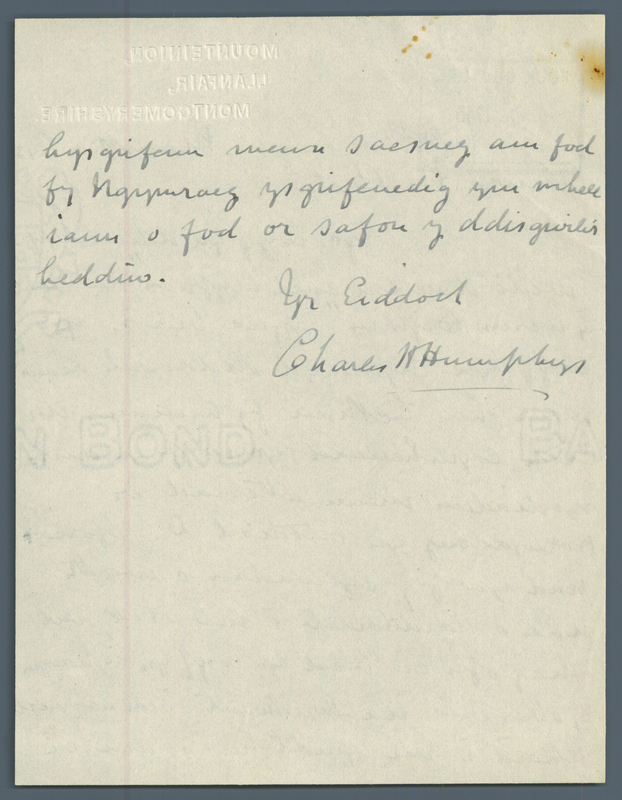

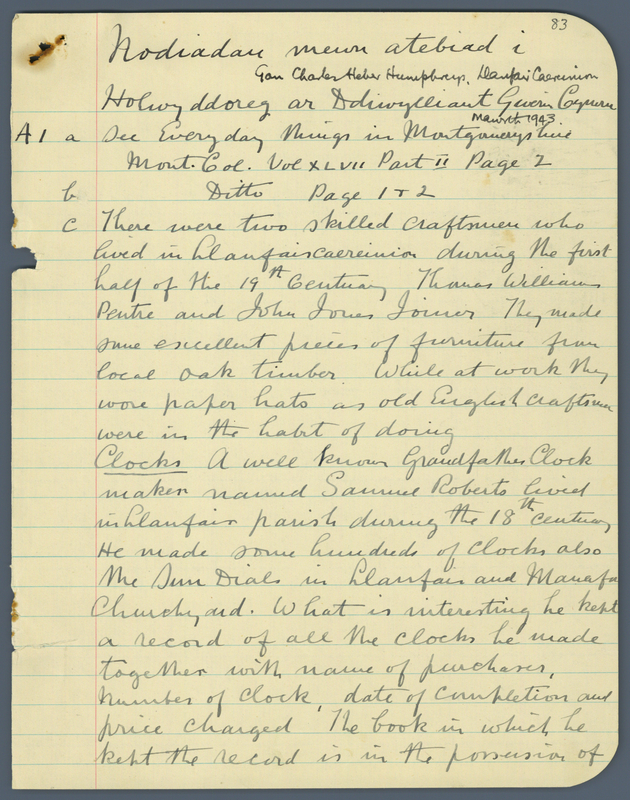



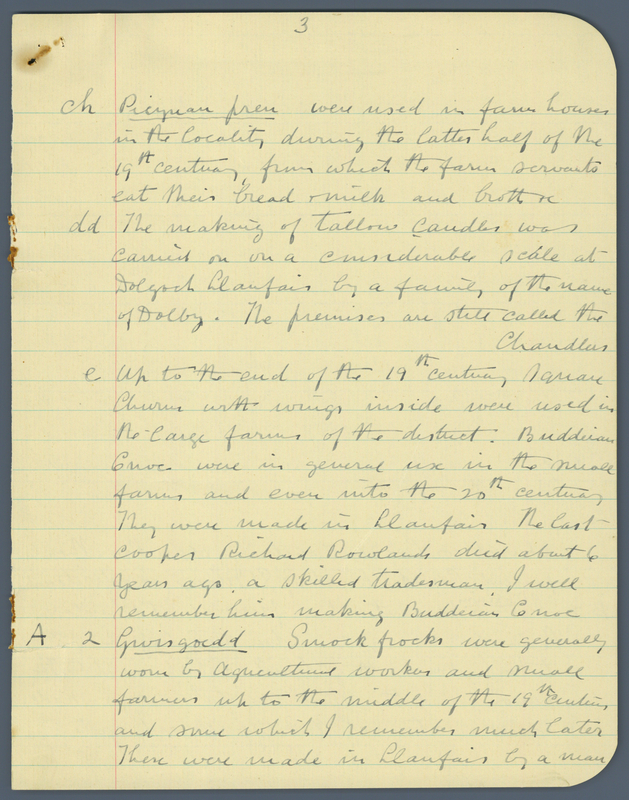

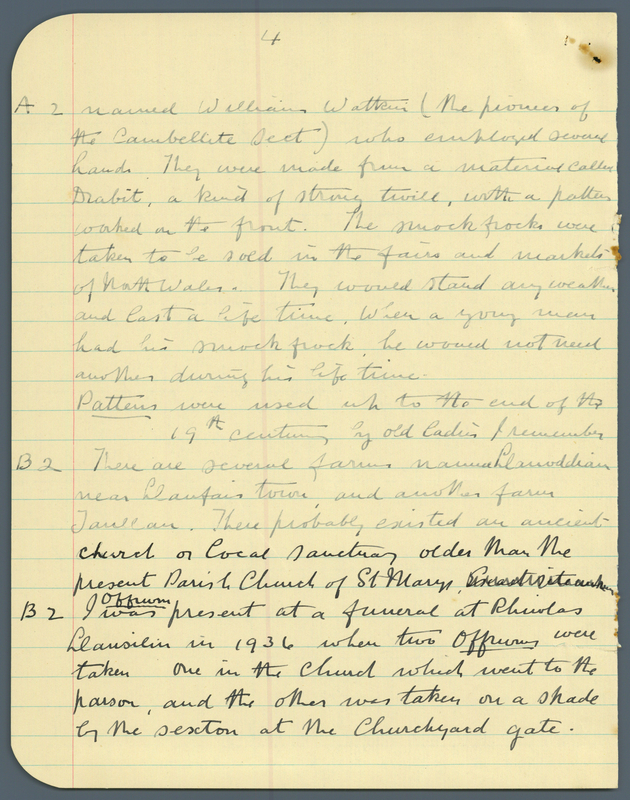

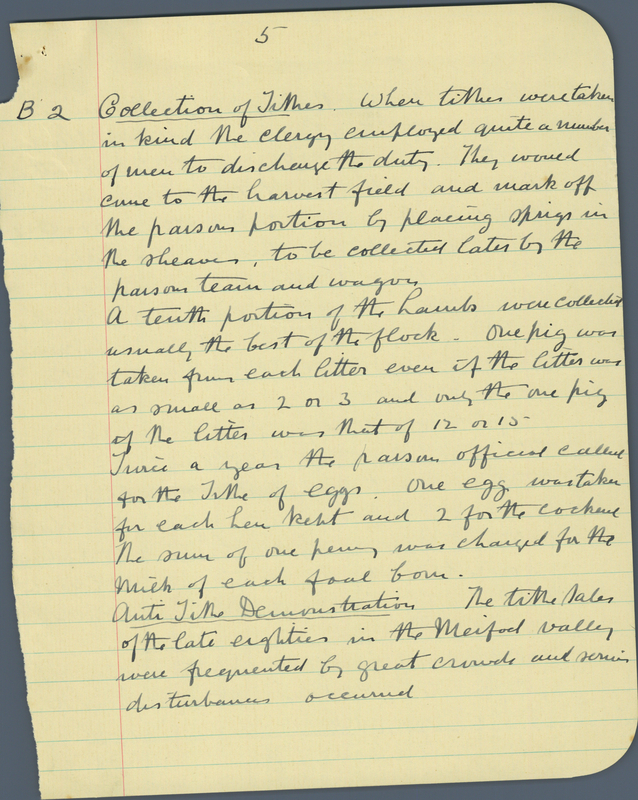





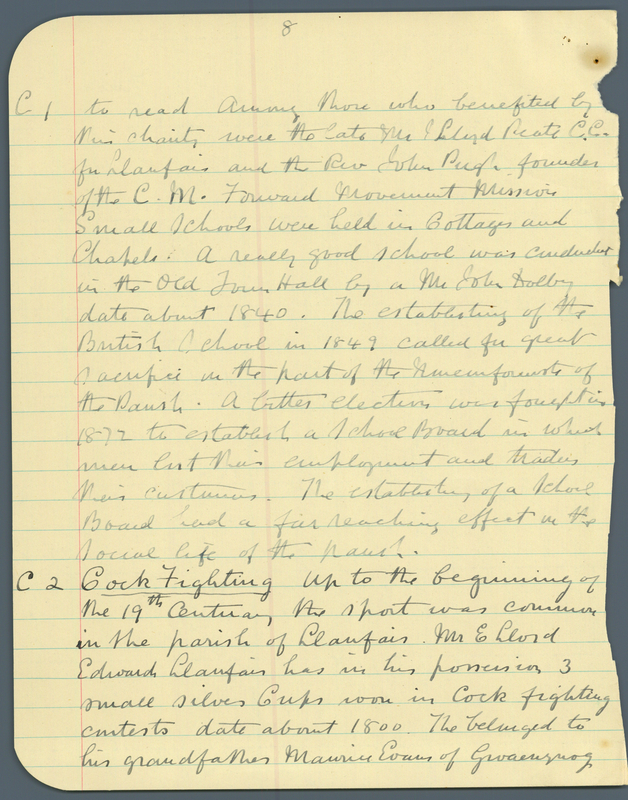

















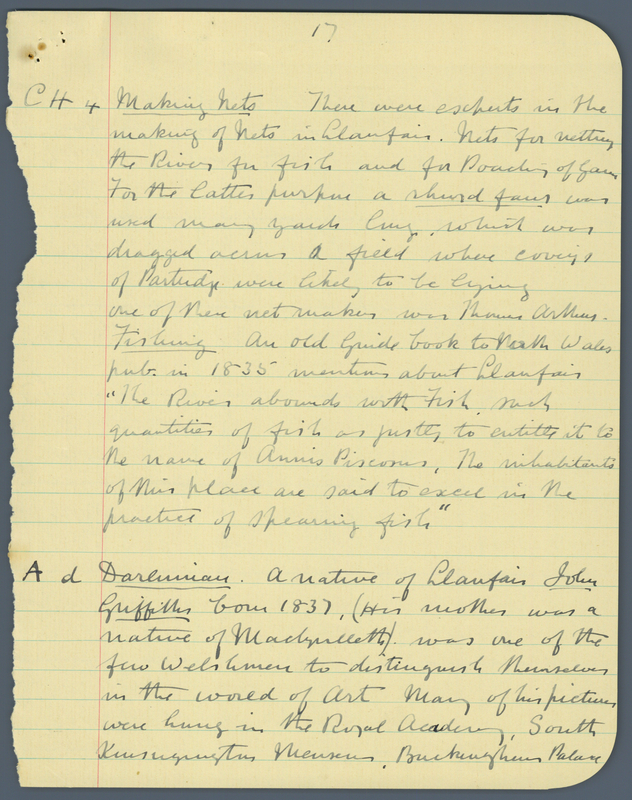




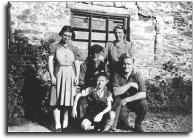

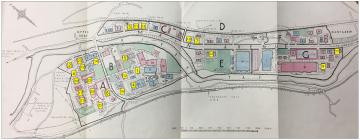

Oes gennych chi wybodaeth ychwanegol am yr eitem hon? Gadewch sylwad isod
Sylwadau (0)
Rhaid mewngofnodi i bostio sylw